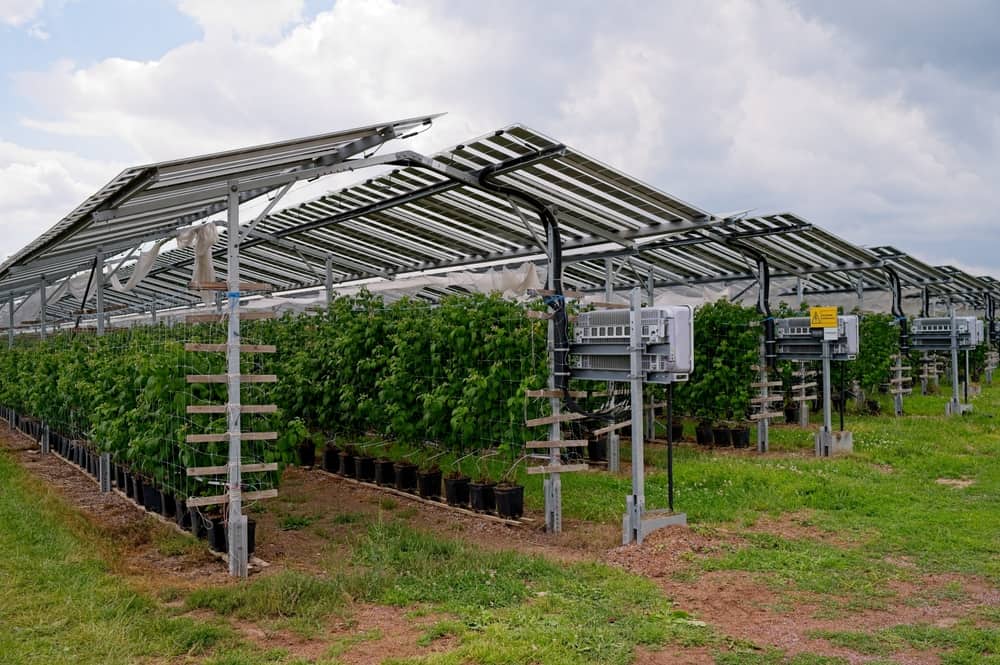
Agrivoltaic farming stands out as an innovative and progressive approach to optimizing land for farmers, blending agriculture and solar energy production. Installing solar photovoltaic (PV) panels over agricultural lands harnesses the dual advantages of generating electricity and fostering crop growth. By selecting the right kind of crop, leasing land for agrivoltaic farming can yield substantial benefits for farmers in Pennsylvania.
What is Agrivoltaic Farming?
At its core, agrivoltaic farming allows agriculture and solar energy generation to coexist in perfect unison. Solar panels are strategically elevated to not only capture sunlight for energy but also to create a beneficial microclimate for the crops underneath. This innovative integration helps to solve the pressing issue of land competition, ensuring both agricultural productivity and solar energy generation can thrive on the same plot.
The arrangement of solar panels is meticulously planned to positively influence the microclimate for various crops, enhancing outcomes based on specific crop needs and local climate conditions. Agrivoltaics transcends mere co-location of farming and solar panels; it’s about maximizing the benefits for both food production and renewable energy generation.
Benefits of Agrivoltaic Farming in PA
For farmers who can grow crops while harnessing sunlight for clean, renewable energy, the advantages are numerous. Here are five important benefits:
Improved Land Use Efficiency
Agrivoltaic farming offers a beacon of hope for farmers in Pennsylvania looking to make the most of their precious land. Solar professionals require a minimum of ten acres of land to develop a community solar project. According to a 2018 plan released by the Pennsylvania Department of Environmental Protection (DEP), Pennsylvania seeks to drive solar power generation up from less than 1% to 10% by 2030. Since Pennsylvania will need an estimated 124 square miles of land to reach that ambitious goal, there’s a greater incentive for solar professionals to entice farmers to lease their land for solar farm development. By raising solar panels higher off the ground, farmers can continue to cultivate precious crops while harnessing the power of the sun without sacrificing one for the other.
Water Conservation
As the planet continues to fight climate change, water conservation is paramount. Agrivoltaics offers a sustainable water management solution. The solar panels’ shade reduces soil moisture evaporation, leading to a decrease in irrigation needs.
Enhanced Crop Yields
Under the protective shade of solar panels, certain crops experience reduced heat stress, leading to potentially higher yields and better quality. This advantage is particularly significant for PA farmers aiming to optimize their agricultural output.
Diversified Farm Income
Agrivoltaic systems enable PA farmers to diversify their income through crop sales and solar energy generation. Land leases for solar last anywhere from twenty to forty years on average, providing steady, passive income for farmers. Agrivoltaic farming’s dual-income approach can help bolster financial resilience against market fluctuations.
Reduced Carbon Footprint
Unlike fossil fuel-driven power plants, solar farms are eco-friendly and produce zero pollution. Integrating solar power with agriculture aids in curtailing greenhouse gas emissions, aligning with PA’s objectives to mitigate its carbon footprint and embrace renewable energy sources.
What Crop is Best for Agrivoltaic Farming in PA?
Several crops can be a great fit for agrivoltaic farming in PA. Here are some popular choices:
Mushrooms
Chester County, PA, “the mushroom capital of the world,” provides approximately half of the nation’s mushroom supply. Mushrooms require controlled light and temperature conditions, which can be effectively managed under the shade of solar panels. This symbiotic environment not only supports mushroom cultivation but also optimizes land use, making it a prime example of how agrivoltaics can be tailored to specific regional agricultural practices.
Broccoli
Broccoli is another crop well-suited for agrivoltaic systems. It typically prefers cooler growing conditions, and the partial shade provided by solar panels can protect it from the harsh summer heat, potentially leading to a longer growing season and increased yields. Maintaining consistent soil moisture levels can contribute to healthier, more robust broccoli plants. According to a 2022 study, researchers in South Korea discovered that growing broccoli under the shade of solar panels leads to a deeper green color and retained moisture versus growing in an open field under direct sunlight.
Leafy Greens
The partial shade from solar panels creates ideal conditions for leafy greens like lettuce and spinach, facilitating their growth in cooler environments, reducing heat stress, and extending the growing season.
Root Vegetables
Root vegetables, such as carrots and beets, benefit from consistent soil temperatures and moisture levels under agrivoltaic systems, contributing to uniform growth and possibly higher yields.
Berries
Berries, including raspberries and strawberries, may thrive under moderated sun exposure in agrivoltaic setups, preventing sunburn and enhancing fruit quality and yield.
Shade-Tolerant Herbs
Herbs that prefer or tolerate shade, like cilantro, parsley, and mint, are excellent agrivoltaic candidates. The reduced sunlight helps preserve their delicate flavors and potentially prolongs the harvest period.
US Light Energy PA Solar Solutions
US Light Energy is a New York-based distributed generation energy development company specializing in community solar facilities and renewable energy solutions. With over thirty years of solar PV, energy industry, and real estate development experience, US Light Energy is poised to support farmers looking to lease their land for agrivoltaic farming. Applying for a land lease in PA is easy! Our solar professionals will handle all the research, evaluate your site, and conduct a pre-application with the utility. US Light Energy is leading the charge for a new generation.
